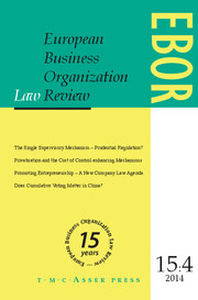Article contents
The Single Supervisory Mechanism – Panacea or Quack Banking Regulation? Preliminary Assessment of the New Regime for the Prudential Supervision of Banks with ECB Involvement
Published online by Cambridge University Press: 17 December 2014
Abstract
This paper analyses the new architecture for the prudential supervision of banks in the euro area. It is primarily concerned with the likely effectiveness of the Single Supervisory Mechanism (SSM) as a regime that intends to bolster financial stability in the steady state.
By using insights from the political economy of bureaucracy it finds that the SSM is overly focused on sharp tools to discipline captured national supervisors and thus under-incentivises their top-level personnel to voluntarily contribute to rigid supervision. The success of the SSM in this regard will hinge on establishing a common supervisory culture that provides positive incentives for national supervisors. To this end, the internal decision-making structure of the European Central Bank (ECB) in supervisory matters provides some integrative elements. Yet, the complex procedures also impede swift decision making and do not adequately solve the problem. Ultimately, a careful design and animation of the ECB-defined supervisory framework and the development of inter-agency career opportunities will be critical.
The ECB will become a de facto standard setter that competes with the European Banking Authority (EBA). A likely stand-off in the EBA's Board of Supervisors will lead to a growing gap in regulatory integration between SSM participants and other EU Member States.
Joining the SSM as a non-euro area Member State is unattractive because the current legal framework grants no voting rights in the ECB's ultimate decision-making body. Nor does it supply a credible commitment opportunity for Member States that seek to bond to high-quality supervision.
Keywords
- Type
- Articles
- Information
- European Business Organization Law Review (EBOR) , Volume 15 , Issue 4 , December 2014 , pp. 449 - 497
- Copyright
- Copyright © T.M.C. Asser Press and the Authors 2014
- 21
- Cited by


